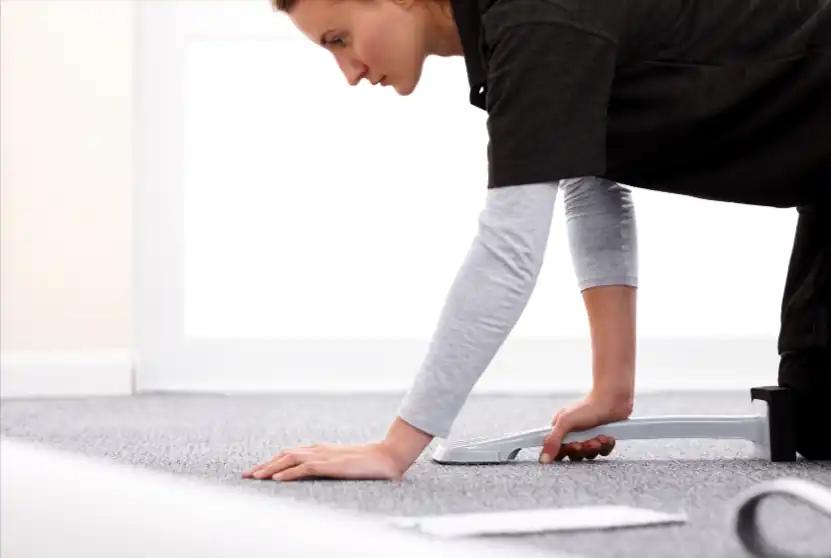There’s a common sight in many homes: a beautiful, albeit wrinkled, carpet that disrupts the otherwise pristine aesthetic of a room. Homeowners often face the conundrum of having to deal with this less-than-optimal situation. One frequently posed question arises: “Can carpet be stretched without moving furniture?” The intuitive response would be a resounding “no,” but the reality is more nuanced and worthy of exploration. The art of carpet stretching, associated with a myriad of considerations, merits a closer examination.
Carpets, much like any textile, exhibit a tendency to warp or buckle over time due to various factors such as foot traffic, humidity changes, or improper installation. Carpet stretching is a solution that not only enhances visual appeal but can significantly prolong the life of your floor coverings. An understanding of the mechanics of carpet and the specifics of carpet stretching techniques sheds light on whether furniture presence inevitably complicates the process.
Typically, professional carpet installers deploy specialized tools to achieve optimal results when stretching. The most common method employed involves the use of a power stretcher, which operates by exerting tension along the length of the carpet, pulling it taut against the floor. This technique requires clear space to navigate the device effectively, and ultimately, the furniture in the room complicates this task.
However, there are methods that allow for stretching carpets even with furniture in place. One approach is to stretch the carpet section by section, carefully maneuvering around the furnishings. Although this method may not yield results as remarkable as a full stretch, it can reduce noticeable ripples and bumps, enhancing appearance to an extent while minimizing disruption.
Of course, this leads into a deeper discussion—why do carpets become wrinkled in the first place? Understanding the underlying causes can help homeowners prevent recurrence. One chief reason involves the initial installation. If the carpet isn’t adequately stretched during installation, it is bound to buckle with time. Additionally, environmental factors such as high humidity can contribute, as moisture encourages the fibers to swell and disrupt the uniformity.
Another contributing factor could be poor padding underneath the carpet. Quality padding contributes significantly to the longevity of your carpet; inadequate support can lead to uneven wear, exacerbating the issue of buckling. Thus, while addressing the stretching of carpets, it’s also wise to evaluate the health of the underlayment.
Let’s take a moment to discuss the significance of stretch and its implications on the aesthetic appeal and functionality of a space. A well-stretched carpet not only looks better but also feels better underfoot, improving comfort levels throughout the home. Moreover, a taut carpet is less likely to trap dirt, dust, and allergens, thereby contributing to a healthier living environment.
So, are there methods to enhance carpet stretch functionality in a cluttered room? Absolutely. One less-invasive technique if moving all furniture is not possible involves utilizing a knee kicker. This tool allows for localized adjustments and, while it may require considerable effort, it does present a solution to alleviate minor ridges in the carpet’s expanse. Moreover, this method can be applied periodically to maintain the carpet’s appearance.
Another approach worth mentioning is the use of furniture sliders or moving pads, which ease the movement of heavy items. Despite suggesting the furniture be moved, it’s a practical option for those wary of inconveniences or potential damage. If you slide furniture out of the way even slightly, it can allow for adequate space to perform minor adjustments, thus facilitating a more thorough stretch operation.
Yet, stretching without moving furniture entirely presents certain limitations. In terms of achieving a result that surpasses mere aesthetics, the most effective scenarios often involve clearing out the entire area. This could also provide an excellent opportunity to do a thorough clean beneath and around the carpet, ensuring that no allergens, dirt, or dust remains trapped. Additionally, it sets the stage for a comprehensive evaluation of the carpet’s condition—you gain insight into whether a patch, repair, or complete replacement may be necessary.
Moreover, contemplating a conversation around extending the lifespan of carpets leads one to consider protective measures post-stretching. Regular vacuuming, professional cleaning, and protective treatments can significantly elevate the longevity of your carpet. These actions, combined with distance from heavy foot traffic, create a perfect environment for your carpets to thrive unrestricted.
In conclusion, while stretching carpets without moving furniture poses challenges, it is indeed feasible with the right tools and techniques. The extent to which one can rectify the issue without moving obstructions relies heavily on the desired outcome—whether a mere aesthetic fix suffices or a more profound structural optimization is sought. The inquiry into carpet stretching not only highlights practical solutions but also underscores deeper elements regarding home maintenance, comfort, and design. Understanding these multifaceted aspects ensures that your carpets remain a staple of your home’s beauty for years to come.
